It pains me just to look at my delicious Cabernet decorating that scrap of old carpet! Anyhow, the first thing I did was pick out the trim I would use for the project. I chose the same simple colonial molding we used on our Dining Room walls. And the rest of the process went something like this:
Decide on white trim or wall-colored trim
I did a little test to see whether I wanted white moldings or moldings painted to match the walls. I was quite sure I wanted them to match the wall, but I didn't want to wonder later how white would've looked, hence the little experiment here:
The white was too 'obvious' against the navy, and might I add any MISTAKES would have been obvious as well. This was a no-brainer!
The height of your room should be the same all around, unless you have dramatically sloping floors or a crooked ceiling. Or wonky vision, in which case I can't help ya. What will definitely vary is the width of your walls. The widths for the walls we wanted to embellish were 88", 72", 56" and 41". Talk about all over the board!
Choose your 'buffer' width
This is the amount of space you want surrounding your boxes. In our dining room, I chose a standard 3" because they were only on the bottom half of the walls. Because this project involved entire walls, I went larger and settled on 5". This may vary a bit as you try to keep the boxes comparable to eachother, but it should stay close to the same number to be visually pleasing. For one wall I did 4" buffers to get the bigger box width I wanted. As long as all the spaces on a single wall are the same, it will be fine.
Do lots of complicated math
You need to 'map' your room so you know where things are going, and how much trim to buy. What it comes down to is this: take your total wall length, subtract the buffer amounts, and then divide the remainder by the number of boxes you want on that wall. Do this all around the room and you will find that some fudging is probably going to be necessary. Here is the largest wall in the room as an example:
This wall was 88 inches. Our buffer near the door needed to be bigger to accommodate the lightswitch, so I didn't factor that one in. Instead, I marked the wall where I wanted the first piece to start, then used that measurement to figure out the 'new' wall length. It came out to be about 80 inches from the first piece (far left) to the wall on the right. Subtracting the two remaining 5" buffer zones, I was left with 70", so we did two 35" boxes. Here are the rest of the walls in comparison:
Did you notice the 'oopsie' and 'duh' captions? I made a mistake by starting my boxes up too high. I thought they would look nicer flush with the top of the vent, and forgot that I had already cut all the long pieces to 75". So, the space above is smaller than the space underneath. I'm seriously over it, though.
Buy trim (this step is a shocker)
I determined from my measurements that we would need 17 (7 ft) pieces of trim for the entire room. It was just under $6 a piece.
Miter both ends of all your vertical pieces
After your measurements are mapped out, and you have purchased your trim, you can cut your identical vertical pieces. Making them all the same length is easy if you cut one, then hold that cut piece on top of the rest and mark them with a pencil. Our ceilings upstairs are only 7.5 ft (90") so with the two 5" buffers and the 5" tall baseboards factored in, we were left with 75" for the vertical pieces. We marked all 12 vertical pieces and cut them all at once. Then I took them downstairs for the next step.
Sand prime/paint your molding
Sanding is important, because nobody likes 'fuzzy' molding. And believe me, even if it seems smooth, it probably isn't. I gave all my pieces a sanding, and then hit them with some dark gray primer that was perfect for under the navy blue paint:
It's wise to prime and paint your pieces after they are cut (to avoid priming areas that you will soon cut off), but that is quite impossible when you are making lots of cuts 'on the fly' like we were. So, I compromised by cutting all the identical pieces before priming, and cutting the varied horizontal pieces upstairs after priming the entire lengths.
Mark your walls for the first piece
I marked the distance from the ceiling, and the distance from the left wall so we knew right where the first piece was going to go. Get your nail gun fired up and ready for action at this point.
Add your adhesive of choice
Preferably with your tongue out, for concentration purposes. Or because you don't want your picture taken. Either way, the tongue helps. We used Liquid Nails, but any 'paneling adhesive' will do. Note: adhesive isn't absolutely necessary, but it helps your piece become as flush with the wall as possible, minimizing caulking later.
Adhere first piece and level, level, level
I would 'hover' the piece as close to the wall as possible without actually touching it, to minimize the gluey mess on the wall. Then I took a long level and held it against the side of the trim, until the bubbles were lined up for the top 20 inches or so. Then I stuck the piece to the wall and pressed firmly on those top 20-30 inches.
Nail that sucker while leveling, leveling, and leveling
After pressing the piece onto the wall, we found it easiest to nail the very top of the piece and then use the level all the way down, nailing as we went. Because LET ME TELL YOU...if you think that piece of trim is not warped, you're probably wrong. Just because it is level the first 30 inches doesn't mean it will be at the end of all 75 inches! Observe the mess we made from getting 'nailgun happy' and then having to remove the offensively crooked pieces (and trying to pound out those nails as well):
It is better to have glue all over your walls from moving it around, than to remove a nailed-in piece and pound it in with a hammer a half inch to the right. Also keep in mind that adjacent walls may be a little crooked, so what looks 'level' on the wall might turn out looking kinda funny in relation. Use your eyeballs AND your level. After some trouble, the first piece was finally up:
Cut your horizontal pieces as you go
We put up the left piece first, then the top horizontal piece, then the right piece, and finally the bottom. It just seemed to work the best for us because the distance from one side of the box to the other was already determined by the top piece being in place. Also, take into consideration the width of your saw blade when making your cuts. Caulk can only do so much if you cut a piece too short!
Caulk the crap out of those babies
I didn't take any photos of the caulked panels, for some reason. I used gray caulk to fill the gaps because it would be easier to cover than white.
Paint
If you did white trim on a colored wall, good luck with your touch-ups! Otherwise, slap paint all over the place like I did. It was awesomely easy, and looked great almost immediately. I put two coats on the trim.
Stand back and enjoy all your hard work!
Materials
17 pieces of trim - $98, the only thing we didn't already have around the house
Caulk
Liquid Nails
Level
Level
Pencil
Miter Saw
Nail gun and compressor
Measuring Tape
Step ladder


.JPG)


.JPG)











.JPG)






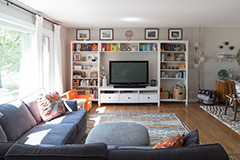
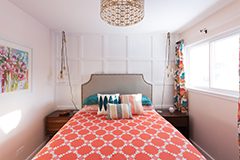
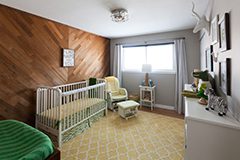
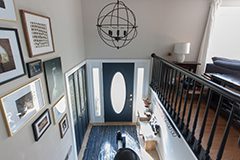


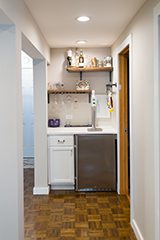
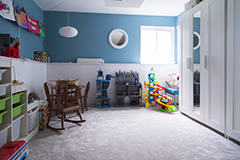
Excellent tutorial. You have a great saw ... I have done mouldings with just a mitre box and saw ... it's still easy! It's all in the planning.
ReplyDeletethis adds so much to your room, and i'm glad that you decided to paint it the wall color.
ReplyDeleteLooks awesome!!! Great tutorial. Going with the wall color was the right choice. Adds a subtle texture. Love it.
ReplyDeleteYou have the best tutorial on this I've seen - not to mention that you made it interesting and fun to read. Thanks for that!
ReplyDeleteTHANK YOU for the wonderful tutorial - we are planning on doing this in our home and have been looking for good play-by-plays. It looks fantastic!
ReplyDeleteOh, my heart. I want to do this in our home so bad. So do people walk into your house and get that shocked look on their face and go 'wowza?' I mean, if they don't know about your blog, your magazine ready rooms must be so intimidating!
ReplyDeleteSharon, you're right that a miter box and saw works. I am just not coordinated enough to use it, I always gouge up my trim!
ReplyDeleteI'm glad everyone likes the tutorial, for some reason this one took me FOREVER to write. Probably because we did so much as we went.
ps - Meg, you totally made my day! My friends are usually pretty impressed when they first see the house, but then I show them the kitchen and they feel totally superior. heh
You are quite the mathematician! I don't think anyone will notice that the molding isn't centered on the top and bottom. It looks amazing - adds so much character to the room! Oh, and I shed a tear for your spilled wine...
ReplyDeleteI don't notice any imperfections, so you fooled me. It turned out beautifully!! Adds such an architectural detail, I'd swear this was one of those historic homes in New York.
ReplyDeleteAnd that color? SCRUMPTIOUS!
P.S. You didn't spill all your wine, did you? I got scared & was going to send you reenforcements from my stash.
ReplyDeleteI have wanted to do this ever since I saw it is Ugly Naked Guys apartment on Friends! It loos wonderful!
ReplyDeleteLooks really sharp! You always give such detailed tutorials. Matching the wall color was definitely the right choice.
ReplyDeleteWhat a great tutorial! There are so many details to adding molding that you do not think about. Love the finished product!
ReplyDeletehi, new to the site, thanks.
ReplyDelete